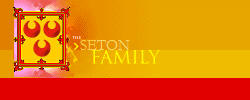|
SIR IAIN BRUCE SETON, 13TH BT, of Abercorn,
Linlithgowshire, Head of the House and Name of Seton.
Born
27 Aug. 1942,
Succeeded
his father 1988.
He was educated at Colchester and Chadacre Ag. Inst. Married
29 Aug. 1963 • Margaret Ann Faulkner,
Daughter
of Walter Charles Faulkner, of Gt. Horkesley, Colchester, Essex, and has
issue.
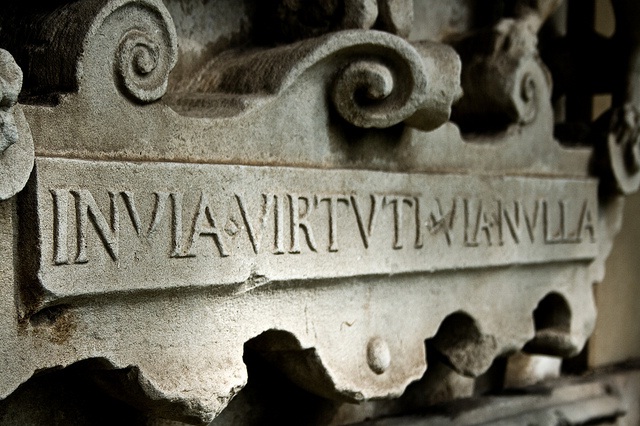 One of the most common questions,
when discussing the House of Seton is who is the Head of the Family? One of the most common questions,
when discussing the House of Seton is who is the Head of the Family?
This can
seem like a
complicated subject for the reader/researcher who is not familiar with either the history of
the lineages of the various families involved, or of the laws and traditions of Scotland that
pertain to the subject. One fact must be
stated before going any further, that in old Scots peerage laws and
traditional customs, a related family member is NOT
entitled to inherit the status of Head of Line, or of Name, from a marriage of one of his, or
her, other marital-related family members.
If, for example, in the case of
two brothers the 1st marries a woman who’s line carries on through her and to her
children, the brother of her husband, cannot and does not, have any claim to her family’s
line. Now in the case of a Title, i.e., Baron, Earl, Marquess, etc… there have been incidents
in history where relations by marriage have successfully claimed a Title, that is another
matter. In this particular case, the purpose of this outline is to answer the much-asked
question of: who is the Head of the Scottish House and Family of the Seton’s?
To clarify this
subject I will follow the general family lines involved to arrive at the conclusion. However,
there are three separate conclusions: There is the Lineal Bloodline Representative of the
Seton’s, The Male-line Representative, and the Senior Representative of the Name of Seton.
The
Male line was conclusively settled by Queen Victoria, upon the Montgomerie-Seton Earl’s of Eglinton,
of that there is no dispute, and I’ll not go any further regarding that subject. However, the
Lineal Bloodline and the Representative of the Name, are different matters.
In both cases,
the Lineal follow the line of the Seton Viscounts of Kingston. To
arrive at this, one starts with George Seton, 5th and last Earl of Winton who died
in 1749 in Rome, s.p.. There has been much discussion over whether he had married a daughter
of a Scotch Physician, a Margaret McKlear and had an only son, Charles Seton, who’s
supposed grandson was
George Seton of Bellingham in Northumberland. This George,
however, died without issue and
since it could not be proved legitimately that the 5th Earl of Winton ever married,
then this claim must be ruled out.
The 5th
Earl of Winton was the eldest son of the two sons of George, 4th Earl of Winton and
Christian Hepburn of Adiston, their second son, Christopher died unmarried in 1704. The 4th
Earl was married 1st to Lady Mary Montgomerie and had a daughter Lady Mary Seton who died aged
three years. The next line, then, rolls back to the 4th Earl's father, George Seton, Master of
Seton/Winton. The Master of Seton/Winton only had the 4th Earl of Winton as a
surviving child of his marriage to Lady Henrietta Gordon, daughter of the Marquess of Huntly,
so we have to roll back another generation to the 3rd Earl of Winton.
The 3rd
Earl of Winton was twice married, 1st to Lady Ann Hay, daughter of Francis Hay, 9th
Earl of Erroll, and 2nd to Elizabeth Maxwell, daughter of the 7th Lord
Herries. From Lady Anne Hay, The 3rd Earl of Winton had, in actuality, 6 children:
George (who died very young), George (who’s line ended with the 5th Earl), Margaret
(who died aged 22, s.p.), Christopher (who died very young), Alexander (who became Viscount
of Kingston), and Francis (who died young).
Following the above, it then falls to the
lineage of Alexander Seton, 1st Viscount of Kingston, for the Bloodline and Name
Representatives of the Seton’s. The following is an extract from the legal
peerage case of the Earl of Eglinton as heir-male general to the Winton Honours,
awarded in 1859, acknowledging the Hay's of Drummelzier (later of Duns Castle)
as lineal heirs of the House and Family of Seton via descent from Alexander
Seton, 1st Viscount of Kingston:
The facts and dates of these marriages, births, and deaths, are all
proved by entries contained in the Family Bible of the first Viscount Kingston,
already referred to, with the exception of the deaths of Archibald, in 1714, and
James, in 1719. The whole of these entries were made by this nobleman himself,
except that of Arthur’s death, which took place two days subsequent to his own;
and the entry of this death, as well as that of the first Viscount himself, was
made by the fourth son Archibald, second Viscount. The Bible, as already stated,
is now in the possession of Mr. Hay of Dunse Castle, who represents the
Kingston family, as heir general, and also the Winton family in the same
character, through his descent from Elizabeth, youngest daughter of Alexander
first Viscount Kingston, by her marriage upon the 25d October 1695, with his
ancestor, William Hay of Drummelzier. The entries of these facts are all made
naturally in the order in which the events themselves took place, and by one who
knew them best. There are, however, other documents produced, confirmatory of
them.
Having extinguished, under the 12th
Head, Christopher Seaton, third son of the third Earl of Winton, the next in the
order of succession was Alexander the fourth son, who was created Viscount
Kingston and Lord Craigiehall. He and his male descendants form a separate
branch, and the four following Heads instruct the marriages and male descendants
of the first Viscount, and the extinction of the whole by the death of James the
third Viscount in 1719, without issue.
Sir
Alexander
1st Viscount
Kingston, Lord Craigiehall and
Baron of Whittingehame, Knight.
That Alexander, afterwards Sir
Alexander Seton, who was the fourth son of the third Earl of Winton, by his
first marriage, was created Viscount Kingston and Lord Craigiehall, by patent
dated 4th January 1651; and that he married four times, viz-----
1st Jean Fletcher,
only daughter of Sir George Fletcher, in February 1650, who died in August
1651. Of this marriage there was issue a daughter.
2nd Elizabeth, sister
and heiress of Sir Archibald Douglas of Wittinghame, on he 22d July 1652, who
died 21 October 1668. Of this marriage there were born seven sons, besides
daughters.
3d Elizabeth Hamilton, daughter
of Lord Belhaven, in 1682, who died 5th June 1685. Of this marriage
there was no issue.
4th Lady Margaret
Douglas, sister of the Marquis of Douglas, upon 4th August 1686, who
died 12 October 1692. Of this marriage, also, there was no issue.
Subsequent to the fourth Earl of Winton’s death in 1704, it has been seen
that the Kingston family were then considered, in the event of the failure of
his two sons, his nearest heirs-male. In the processes which ensued upon this
account between George the attainted Earl and the Kingston family, Archibald
Viscount Kingston, was the principal party against the latter. For this see the
evidence under the 10th Head.
Contract between Archibald Viscount Kingston and Mr. James Seton, his
brother, dated 26th March 1718, whereby the Viscount dispones to the
above James Seton the Barony of Whittinghame, under burden of an aliment to
himself of 2000 marks.
Libelled Summons before the Court of Session, signeted 23d May 1710, with
execution thereon, dated 24th May 1710, at the instance of Archibald
Viscount of Kingston, nearest and lawful appearand heir to the deceased George
Earl (fourth Earl) of Winton.
That this James, third Viscount
Kingston, married in 1714 Lady Anne Lindsay, daughter of Colin Earl of Balcarras,
and widow of Alexander Earl of Kellie; and that he was attainted for the
Rebellion of 1715; and died in 1719, without issue.
Post-nuptial Contract, dated 16th April 1714, between Mr.
James Seton, brother german to the Viscount of Kingston and Anna Countess of
Kellie. By this contract the Countess is provided to a liferent of 20 chalder
of victual by locally, to commence after the Viscount’s decease; and besides
this, the contract contains a provision in case of the Contess’ survivance, and
that there be nae bairns procreated of the marriage betwixt them existing the
time of his decease; in which case the Viscont disponed to the Countess, the
haill inside plenishing and movable goods and gear in his dwelling house the
time of his death. But if there shall happen to be children, one or more,
existing the time of his decease, the Viscount in that case disponed to the
Countess only the just and equal half of the said inside plenishing. This shows
the provisions made in either of the events, -- of there being issue of the
marriage, or of the survivance of the Countess. This contract was afterwards
followed by instrument of sasine in favour of the above Anna, now Viscountess of
Kingston, dated 17th December 1719, and recorded in the particular
Register at Edinburgh, 4h January 1720. The sasine not only proceeds upon the
above marriage contract, but also upon a contract of alienation betwixt William
Hay of Drummelzier, and James, late Viscount of Kingston, now deceased, therein
designed James Seton, second lawful son in life of the deceased Alexander
Viscount of Kingston, dated 26th March 1713.
This proves that, at the date of
the sasine, 17th December 1719, James the third Viscount had
deceased.
Thereafter, upon 2d
February, 1720, Anna, Viscountess of Kingston, obtained decree of locality in
the Court of Session, against William Hay of Drummelzier, and the other parties
liable by the above-mentioned post-nuptial contract. In this decree there was
obtained a decerniture for the one-half of the crop and year 1719 years, in
regard the said James late Viscount of Kingston did decease before the term of
Martinmase 1719. The decreet also narrates the above provision. In case of her
(the Viscountess) survivance and failing children existing of the marriage
between them, whereby she was to have right to the haill inside plenishing; and
subsumes that the pursuer (the Countess) has thereby good and undoubted right to
call and pursue for the said household plenishing.
This latter part proves that there
were no children existing of the marriage between James third Viscount of
Kingston and Anna Viscountess Kingston; and that his Lordship died prior to
Martinmas 1719.
From his first
marriage, the 1st Viscount Kingston had 1 child: Jean (who married James Douglas, 3rd
Lord Mordington and where there is no succession). From his second marriage he had 7 sons and 3 daughters: Charles, George and
Alexander, all of which died, s.p., Archibald (who succeeded as 2nd Viscount but
d.s.p.), Arthur (who died young), John (who died young), James (who succeeded as 3rd
Viscount and d.s.p.), Isabel (who died young), Barbara (who died young), and Elizabeth, who
married the Hon. William Hay of Drummelzier, son of John Hay, 1st Earl of Tweedale,
in 1695. She became the heiress of the Kingston line and brought Whittingehame to that family. Alexander Seton, 1st Viscount
Kingston had no other children from his other two marriages, and died 21 Oct., 1691 at
Whittingehame.
In the
Male-line issue for the Seton-Winton Honours, the descent of the Viscounts of Kingston
obviously got passed over, not the least of which by somewhat less than
honourable means: noting of course that the original continuation of the honours
and line of the House of Seton also previously followed the heiress Margaret
Seton when she married Alan de Winton, her Seton-cousin, and ensured the lineal
and honourable continuation of the bloodline (despite the lesser bloodline Seton
of Parbroath family's direct male-line claim), and where their son William
retained his mother's name and became the 1st Lord Seton, and Head of the House
and surname of Seton and continued the line.
The lineal bloodline representation of the House of
Seton then, passes to the descent of Elizabeth Seton of the Kingston Family and
from her marriage to William Hay of Drummelzier. William Hay of Drummelzier was
himself the son of Margaret Montgomerie, daughter of Alexander Seton, 6th
Earl of Eglinton, and was already a daughters cadet of the House of Seton.
He was the son of John Hay, 1st Earl of Tweeddale from his second marriage to
Margaret Montgomerie, daughter of Alexander Seton 6th Earl of Eglinton, where
John Hay's first marriage was to Lady Jean Seton, daughter of Alexander Seton,
1st Earl of Dunfermline who's only child John Hay became 1st Marquess of
Tweeddale (William's half-brother).
William Hay and
Elizabeth Seton’s oldest surviving child was, Alexander Hay of Drummelzier and Duns Castle. He
was married twice, 1st to Anne, daughter of Alexander, 5th Lord Blantyre,
and 2nd to Jean Hay, daughter of David Hay of Belton where they had
no children. Of Alexander Hay’s line, only two of his children produced
heirs: his older daughter
Margaret, and his younger son Robert (later successor to his father and ancestor
of the Hay's of Duns Castle). Margaret Hay was then was the oldest lineal
surviving child to produce an heir, and the Seton-bloodline lineally follows
her. She married Sir Henry Seton, 4th Baronet of Abercorn in 1770, passing
the lineal bloodline back into the House of Seton directly, and their son,
Alexander Seton, 5th Baronet of Abercorn became then, the lineal heir of the
House and Family of Seton. It is
from his line that the senior bloodline representative of the House and Family
and name of Seton-Winton stems, who also bear the name is Seton legitimately in
the male-line outright, and Scots tradition
in so bearing the name of Seton and with their lineal status they became, and remain, the
lineal bloodline representatives of Head
of the House and Family of Seton-Winton.
The Seton Baronets of Abercorn are also the
lineal heirs of the Seton's of Touch and representatives of that line, making
them the rightful Hereditary Armour Bearers to the King (Queen). And also
as a result of their lineal representative status of the Seton's of Touch they
are the heirs lineally of Alexander Seton, 1st Earl of Huntly, and thus the
de jure Lords Gordon, which Honour the Seton's of Touch never ceased to
claim. It would also be important to note that while the Charter of the
Earldom of Winton likely is to male-heirs only by it's original patent, the
Lordship and Barony of Seton and that of Tranent was for heirs of the body,
tradition dictating bearing the name of Seton, particularly due to the
significance. This makes the Seton's of Abercorn also the de jure
Lords Seton as well. This converges lineally the line of the Lords Seton
and Gordon, and the Earldoms of Winton and Huntly into one bloodline, and,
following their descent, the Seton's of Abercorn are also heirs to the Viscounty
of Kingston.
Baronets of
Abercorn Viscounts of Kingston The Earldom of Winton
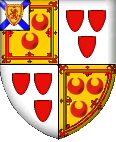
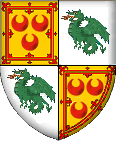

There is however, one other
facet to consider:
By tradition, the representation of
a family-line was continued only in the Male bearing the name, unless in the case of failing
male-heirs, where the heiress being female, the daughter's son took his mother's
name and therefore the line continued unbroken. If this was not the case,
then the line would fall back to the nearest heir-male of line bearing the
name.
As per the Royal Charter obtained by
George Seton, 4th Earl of Winton dated 31 July 1688: was granted to him of the
Earldom of Wintoun, to him and the heirs male of his body, which failing, to
whichever person he might nominate and the heirs male of their bodies, with
remainder to his heirs male, and failing these to his nearest heirs and
assignees whatsoever, the eldest daughter or her female succeeding without
division, and marrying a gentleman of the surname of Seton, or who would assume
that surname and carry the Wintoun Arms.
In the Seton line, with male heirs
failing the senior line (including that of the unofficial line of George, 5th Earl of Winton),
the nearest male heir would in fact be that of the Montgomerie Earl of
Eglinton's, who being originally Seton's had their name changed by King James VI
to that of Montgomerie on their accession of the Eglinton Earldom from their
maternal Margaret Montgomerie's being heiress. However, that change
was strictly specified by the King that they were then to be Montgomerie's, and
never to again be Seton. Therefore the Montgomerie Earl's of Eglinton-line
while attaining the Titles
are not entitled to be head of the House, Line or Name of Seton.
The Representation of the Male line
of Seton bearing the Name then, falls to that of
the Seton's of St. Germains, of the line of the Hon. Sir John Seton of St.
Germains, 5th son of Robert, 1st Earl of Winton, which line has not been fully
documented; or failing that line, that of the Seton's of Barnes as descended
from Sir John Seton of Barnes, Lord Barnes and Knight of the Order of St. Iago in Spain, and who's line are the Representatives and Heirs to the
Earldom of Dunfermline. While the Seton of Barnes and Hailes line is also
still being actively researched, the senior female-line Seton-Coventry descent
of Vice-Admiral James Seton, Governor of St. Vincent and the Grenadines and
Representative Earl of Dunfermline and of Barnes and Hailes line has now only
the last male-heir without further male-heirs; the descent in the Male then
falling to either his other younger son's or to the Seton's of Nova Scotia.
While this discussion remains for
the time being ongoing, and the question unanswered, it is the preference of the
Seton family to have the line continued in the correct, unbroken tradition.
It would therefore seem that in the event of a Seton of Barnes succession, that
a grand-quartering of the Earldom's of Winton and Dunfermline arms' be enacted.
Sir John Seton of Barnes Seton
of St. Germains Seton of Barnes (later)
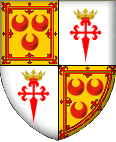

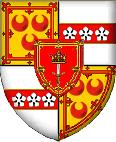
|
